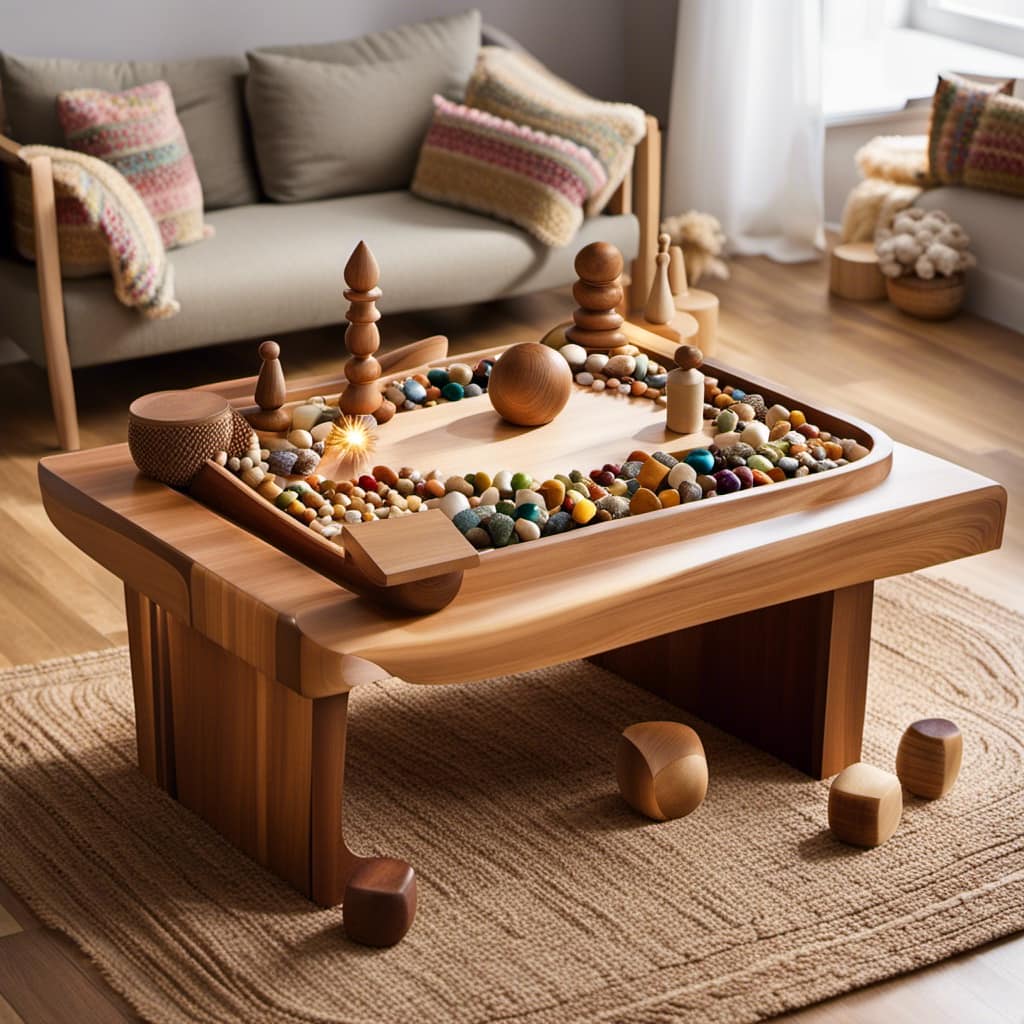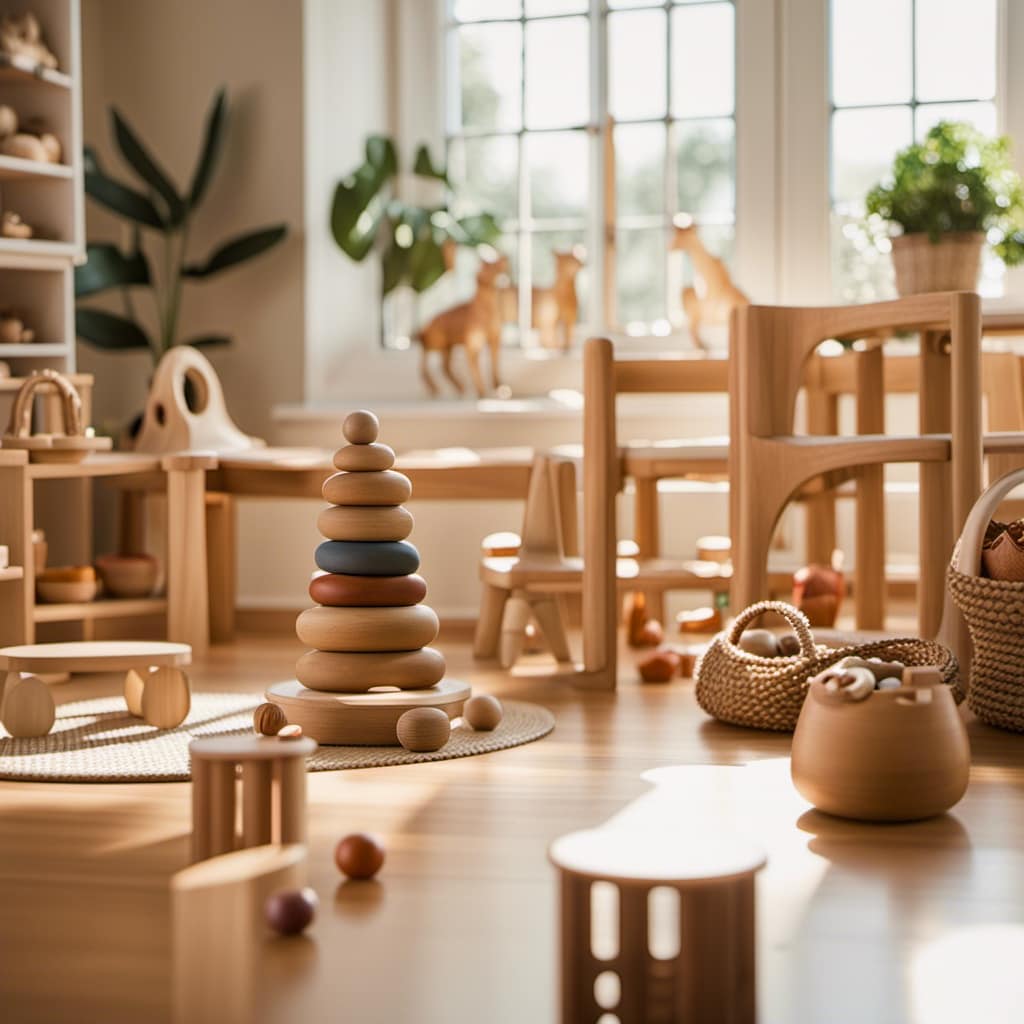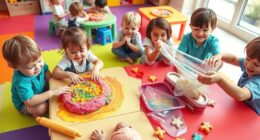I have always believed that having a structured environment is important for teaching children self-reliance and organization. Did you know that having storage solutions for Montessori toys can help develop these important skills?
By implementing principles such as toy rotation, organizing toys by age, and using child-sized storage containers, we can create a visually engaging and structured play area that promotes concentration and independent play.
In this article, I’ll explore the benefits of Montessori toy storage and share effective strategies for organizing and maintaining a clutter-free toy area.
Key Takeaways
- Promotes independence, creativity, and orderliness
- Develops a sense of responsibility and ownership
- Encourages purposeful play and decision-making skills
- Fosters a neat and tidy play area
Key Benefits of Montessori Toy Storage
Montessori toy storage promotes my independence and orderliness, allowing me to develop a sense of responsibility and ownership.
By having a structured and intentional approach to toy organization, I am encouraged to make purposeful decisions and engage in creative play.
Montessori toy storage fosters my independence by giving me the freedom to choose and access my toys easily. This promotes decision-making skills and allows me to explore different play experiences.

Additionally, having an organized play area fosters creativity as it reduces distractions and enhances my focus. I can easily find and engage with my toys, leading to more imaginative and open-ended play.
With Montessori toy storage, I am empowered to take ownership of my play space and develop important life skills.
Essential Principles of Montessori Toy Organization
When organizing toys, I prioritize accessibility for the child and arrange them in an orderly manner. Here are some practical tips for Montessori toy organization and effective toy rotation:
-
Montessori Toy Rotation: Implement a rotating toy system to keep playtime fresh and engaging. Rotate toys regularly, such as every two weeks, to prevent overwhelming clutter and promote a more engaging play environment.
-
Organizing Montessori Toys by Age: Categorize toys by age groups and create designated storage spaces for each group. Use clear bins or labeled shelves to ensure toys are easily accessible and organized.
-
Creating Order: Teach children the value of organization and tidiness. Create a dedicated space for each toy category or theme, using practical toy storage solutions and open-ended storage solutions.

-
Follow a Systematic Approach: Create a schedule with designated playtimes and organize toys into categories, such as building blocks or pretend play. This promotes a sense of order and responsibility while enhancing concentration and independent play.
Montessori Toy Rotation: An Effective Approach
Implementing a rotating toy system keeps playtime fresh and engaging for my child. Montessori toy rotation simplifies playtime by reducing clutter and overwhelming choices.
By rotating toys, I encourage creativity and exploration in my child’s play. It allows them to focus on a few toys at a time, giving them the chance to fully engage and explore each one.
This approach also promotes independence as my child learns to make choices and take responsibility for their playtime. By designating specific play areas and grouping toys by category, I create a visually pleasing and organized environment.
This not only enhances their concentration and attention span but also fosters a sense of orderliness and responsibility.
Overall, implementing a rotating toy system has been a game-changer in simplifying playtime and encouraging my child’s creativity and exploration.

Organizing Montessori Toys by Age: A Guided Approach
By categorizing toys according to age, I am able to create a more tailored and engaging play experience for my child. This approach ensures that my child is playing with toys that are developmentally appropriate and suit their current abilities and interests.
Here are the key benefits of organizing Montessori toys by age:
-
Age-appropriate toys: By organizing toys by age, I can ensure that my child is playing with toys that are suitable for their developmental stage.
-
Promotes skill development: Age-appropriate toys help my child develop essential skills such as fine motor skills, problem-solving, and cognitive abilities.
-
Enhances engagement: When my child is playing with toys that are designed for their age, they are more likely to be engaged and interested in the activity.
-
Supports learning: Organizing toy materials by age allows me to provide my child with educational and stimulating toys that promote learning and growth.

Choosing the Right Storage Containers for Montessori Toys
I found that using child-sized storage containers for my child’s toys makes it easier for them to access and put away their belongings. Child-sized containers allow children to independently access and put away their toys without the need for adult assistance. This promotes a sense of ownership and responsibility.
When choosing the right storage containers for Montessori toys, it is important to consider container size and accessibility, as well as material and durability. Containers made from durable materials ensure that they can withstand the wear and tear of everyday play. It is also important to prioritize accessibility, as children should be able to easily reach and see their toys.
Creating a Dedicated Montessori Play Area: Design and Organization
To create a dedicated Montessori play area, I can arrange the toys in an organized manner using open shelving and group materials by category. This will help in designing a child-friendly space and promoting creativity through toy organization.
Here are some key steps to follow:
-
Use open shelving: Open shelves allow easy access to toys and promote independence in choosing and tidying up.
-
Group materials by category: Categorizing toys like blocks, puzzles, and art supplies helps children locate what they need and fosters a sense of order.

-
Implement a rotating toy system: By periodically swapping out toys, you can provide a fresh and engaging play experience while reducing boredom.
-
Promote creativity: Arrange toys in an organized manner, allowing children to easily see and access their options, encouraging imaginative play and exploration.
Implementing Toy Rotation and Maintaining a Clutter-Free Space
Implementing a regular toy rotation system helps maintain a clutter-free space and keeps the play area engaging and organized. Toy rotation involves selecting a set of toys and temporarily storing the rest. This approach encourages children to focus on a smaller, curated selection of toys, promoting creativity and reducing overwhelm.
To implement toy rotation effectively, start by organizing toy storage into different categories or themes. Use clear bins or labeled shelves to ensure easy access to toys. Rotate toys regularly, such as every two weeks, to provide a fresh and exciting play experience. This not only prevents clutter but also keeps children interested and engaged.
The Benefits of Toy Rotation in Montessori Toy Storage
By regularly rotating my child’s toys, I create an engaging and organized play area that promotes creativity and reduces overwhelm.
The benefits of toy rotation in Montessori toy storage are numerous. Firstly, it encourages variety and novelty, keeping my child interested and excited about their toys.

Secondly, it helps to prevent overstimulation and reduce clutter, allowing for a more focused and calm play environment.
Thirdly, toy rotation promotes independent play and decision-making skills, as my child learns to choose and explore different toys.
Lastly, it encourages resourcefulness and creativity, as my child finds new ways to play with familiar toys.
Implementing toy rotation is simple and effective. I categorize toys, create designated storage spaces, and rotate them regularly to provide a fresh and engaging play experience for my child.
Categorizing Toys by Age: A Systematic Approach
When categorizing toys by age, I find it helpful to follow a systematic approach for organizing and rotating them regularly. This ensures that children have access to age-appropriate toys that promote their development and keep them engaged.
Organizing toys effectively is essential for creating a stimulating and orderly play environment. By categorizing toys by age group, it becomes easier to select the right toys for each child’s stage of development. This approach also allows for easy toy rotation, ensuring that children have a variety of toys to play with while preventing overwhelming clutter.
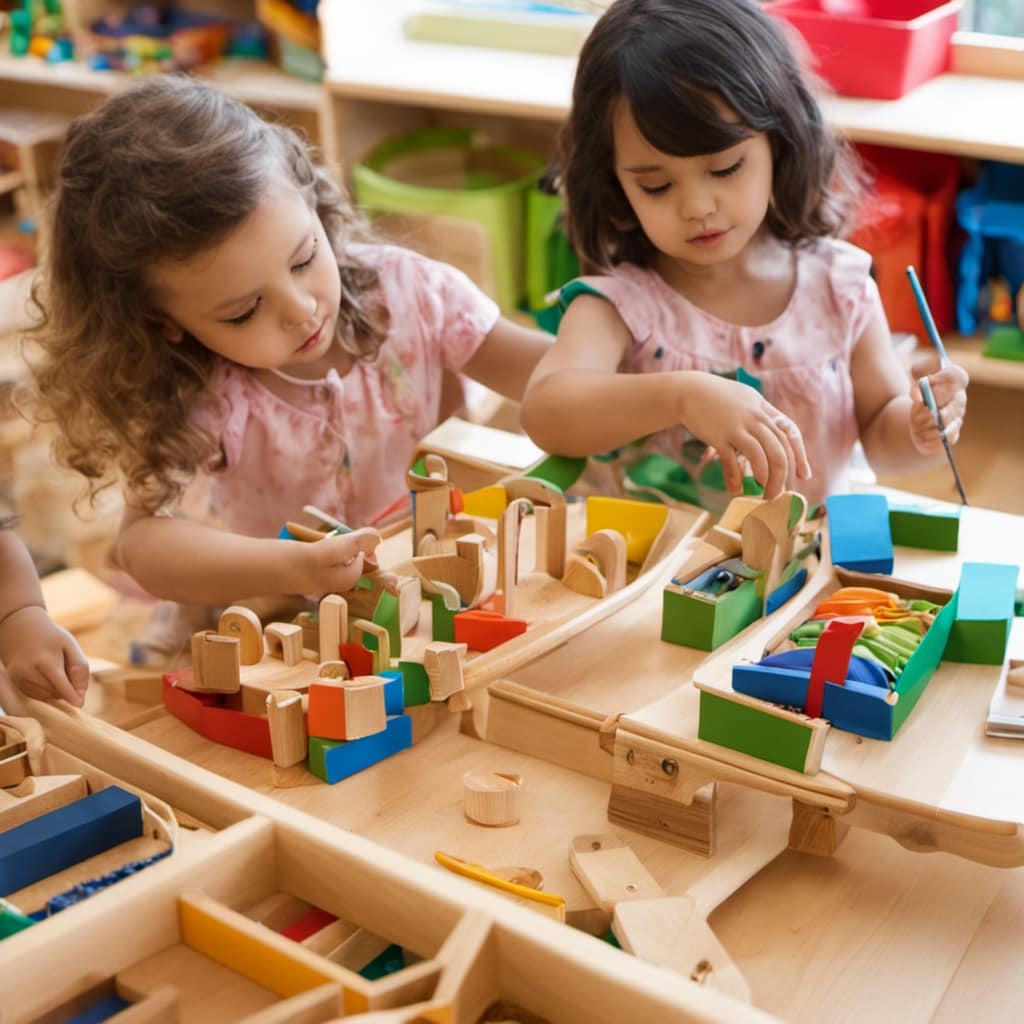
Organizing Toys by Category: Creating Orderliness
I find that organizing toys by category is an effective way to create a sense of orderliness in the play area. Here are the benefits of organizing toys by category and some effective toy rotation techniques:
-
Promotes organization: Categorizing toys helps children understand where each toy belongs, fostering a sense of order.
-
Easy toy rotation: By organizing toys by category, it becomes simpler to rotate toys regularly. This ensures that children have a variety of play options and prevents them from getting bored with the same toys.
-
Encourages exploration: When toys are grouped by category, children can easily find what they are looking for, promoting independent play and exploration.
-
Enhances creativity: Having toys organized by category allows children to see the different possibilities and combinations, sparking their creativity and imagination.
Teaching Children the Value of Organization and Tidiness
Teaching children the value of organization and tidiness has numerous benefits for their development and daily routines.
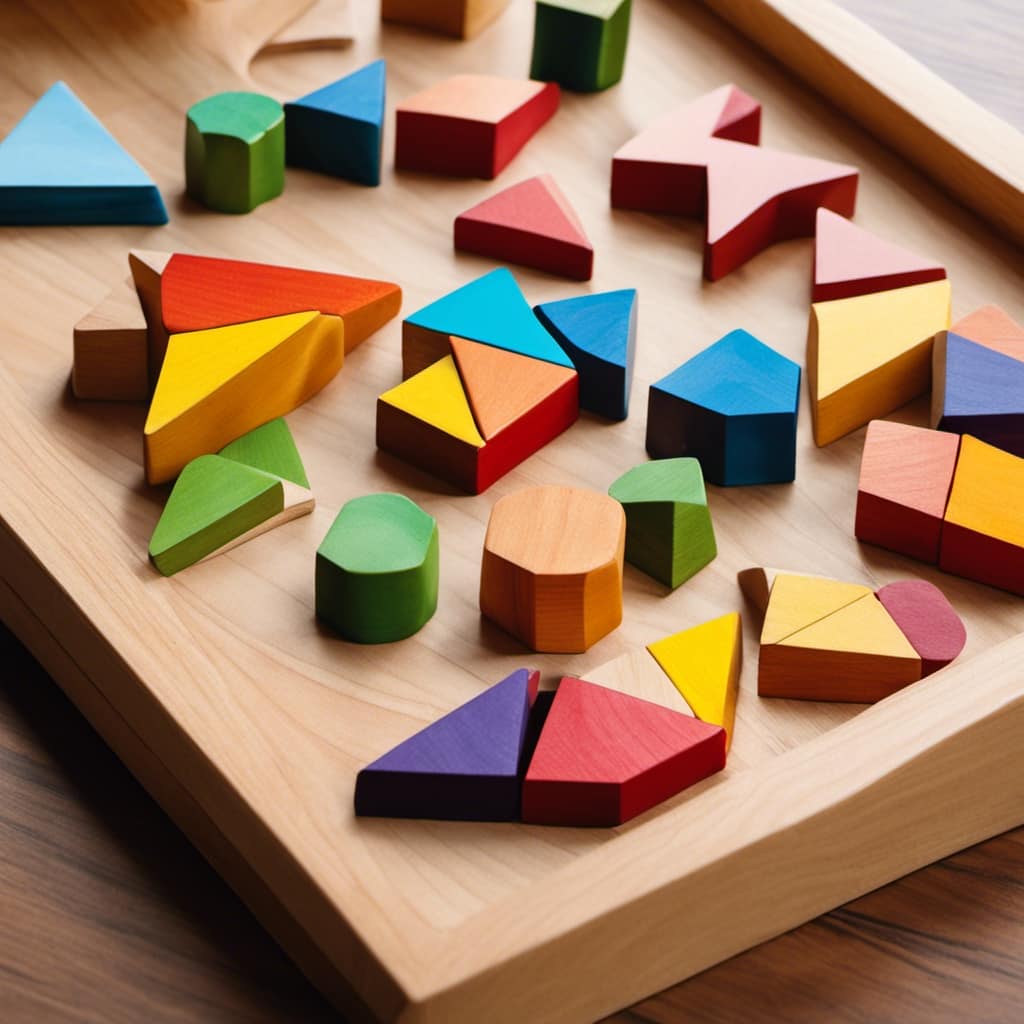
By teaching organization skills, we are promoting cleanliness and orderliness, which are essential life skills. When children learn how to keep their belongings organized, they develop a sense of responsibility and ownership. They also learn decision-making skills and the importance of taking care of their belongings.
Moreover, teaching children to be organized helps them in their daily routines, such as getting ready for school or completing homework. It also promotes a sense of calm and reduces stress in their environment.
Frequently Asked Questions
How Can Montessori Toy Storage Promote Independence in Children?
Montessori toy storage encourages self-reliance and teaches responsibility. By providing an organized and accessible play area, children can independently choose and put away toys, fostering a sense of independence and orderliness.
What Are Some Practical Storage Solutions for Montessori Toys?
Practical storage solutions for Montessori toys include organizing toys by type, using labeled bins or shelves, and providing easy accessibility. This helps promote independence and orderliness while allowing children to easily find and engage with their toys.
How Often Should Toys Be Rotated in a Montessori Toy Storage System?
Toys should be rotated in a Montessori system every two weeks. This frequency promotes engagement, reduces clutter, and creates a more stimulating play environment. Regular rotation enhances concentration, creativity, and independent exploration.
How Can the Organization of Montessori Toys by Age Benefit a Child’s Development?
Organizing Montessori toys by age can benefit a child’s development by providing age-appropriate toys that stimulate their interests and abilities. Toy rotation ensures a fresh play experience and fosters creativity while promoting independence and orderliness.

What Role Does Creating a Dedicated Play Area Play in Montessori Toy Storage?
Creating a dedicated play area in Montessori toy storage promotes independence and orderliness. It allows for practical storage solutions and encourages toy rotation frequency. Age-based organization benefits children’s development by providing a focused and engaging play environment.
Conclusion
In conclusion, Montessori toy storage is like a beautifully orchestrated symphony. Each toy has its designated place, and harmony fills the air. By implementing the essential principles of organization and using child-sized storage containers, we create a world of independence and orderliness for our children.
Toy rotation becomes a mesmerizing dance as toys take turns captivating little minds. Through categorization and creating visually pleasing environments, we nurture a sense of responsibility and teach the value of organization.
So let us embark on this Montessori journey, where tidiness and independence thrive hand in hand.




